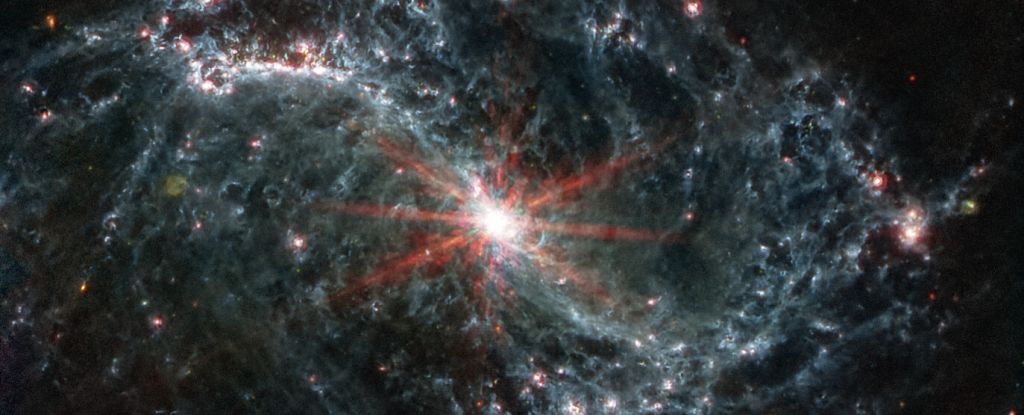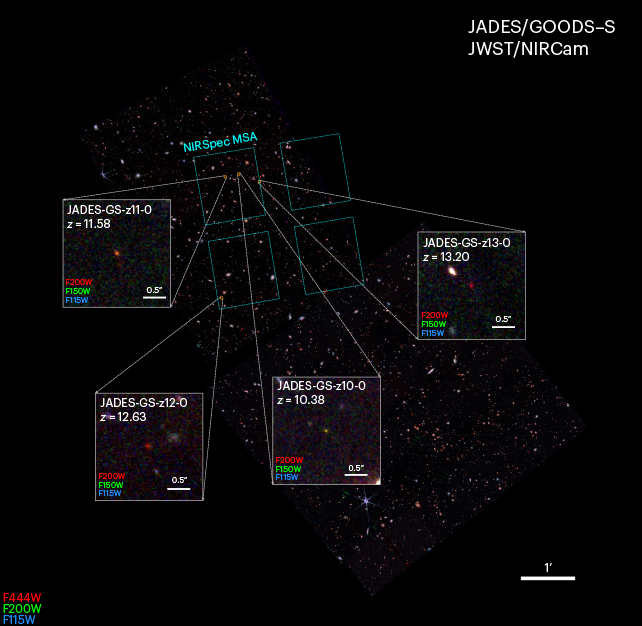JWST captures details of four distant galaxies
- April 6, 2023
- 0
According to new research from Tuesday, the James Webb Space Telescope has discovered the four most distant galaxies ever observed; one of them formed just 320 million years
According to new research from Tuesday, the James Webb Space Telescope has discovered the four most distant galaxies ever observed; one of them formed just 320 million years

According to new research from Tuesday, the James Webb Space Telescope has discovered the four most distant galaxies ever observed; one of them formed just 320 million years after the Big Bang, when the universe was still in its infancy. Since the Webb Telescope went live last year, it has made a number of scientific discoveries by looking more than ever into the far reaches of the universe – which also means going back.
When light from the most distant galaxies reached Earth, it was stretched by the expansion of the universe and shifted to the infrared region of the light spectrum. The Webb telescope’s NIRCam instrument has the unprecedented ability to detect this infrared light, allowing it to quickly detect an unprecedented array of galaxies; some of these could change astronomers’ understanding of the early universe. Two studies published in the journal Nature AstronomyAstronomers have revealed that they have “conclusively discovered” the four most distant galaxies ever observed.

The galaxies date from 300 to 500 million years after the Big Bang, more than 13 billion years ago when the universe was only two percent of its current age. This means that the galaxies came from the so-called “reionization age”, when the first stars were thought to form. This period came just after the cosmic dark ages caused by the Big Bang.
Stéphane Charlot, a researcher at the Paris Institute for Astrophysics and co-author of two new studies, told AFP that the most distant galaxy, JADES-GS-z13-0, formed 320 million years after the Big Bang. According to him, this is the largest distance ever observed by astronomers.
The Webb telescope also confirmed the existence of JADES-GS-z10-0, which dates back 450 million years after the Big Bang and was previously detected by the Hubble Space Telescope. According to Charlot, all four galaxies are “very low mass” and weigh about a hundred million solar masses. By comparison, the Milky Way is estimated to weigh 1.5 trillion solar masses.
But, Charlot said, galaxies “form stars very actively in proportion to their mass.” These stars formed at “about the same rate as the Milky Way,” he added. The galaxies were also “very metal-poor,” he added.
This is consistent with the Standard Model of Cosmology, the best scientific understanding of how the universe works, which says the closer you are to the Big Bang, the less time there is for such metals to form.
But the February discovery of six large galaxies that formed between 500 and 700 million years after the Big Bang has some astronomers questioning the standard model. Also observed by the Webb telescope, these galaxies were larger than previously thought possible shortly after the birth of the universe – if confirmed, the Standard Model may need an update.
Peter van Dokkum, an astronomer at Yale University who was not involved in the recent research, hailed the confirmation of four recently discovered distant galaxies as a “technical showdown.” “The border moves almost every month,” commented Van Dokkum. nature magazineHe added that “between these galaxies and the Big Bang, the universe has only 300 million years of unexplored history.” According to him, the Webb telescope has observed possible galaxies even closer to the Big Bang, but these have yet to be confirmed.
Source: Port Altele
As an experienced journalist and author, Mary has been reporting on the latest news and trends for over 5 years. With a passion for uncovering the stories behind the headlines, Mary has earned a reputation as a trusted voice in the world of journalism. Her writing style is insightful, engaging and thought-provoking, as she takes a deep dive into the most pressing issues of our time.